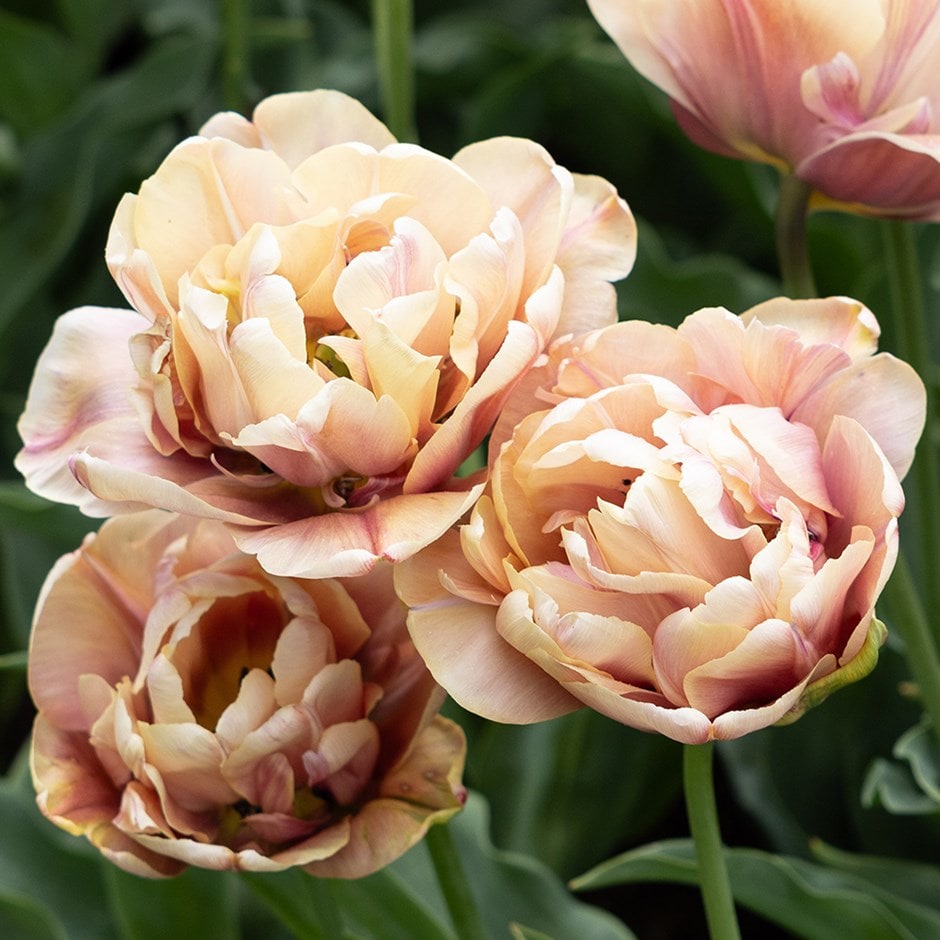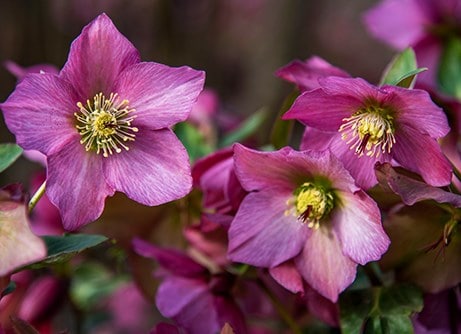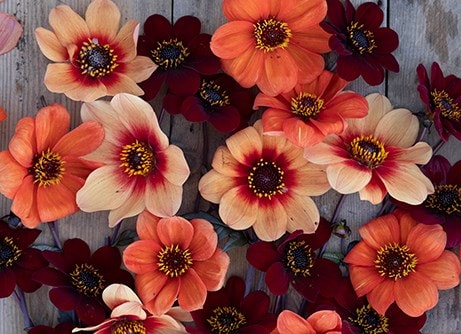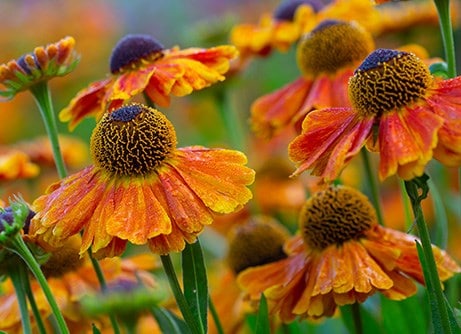
Initially, the flowers of this exquisite and unusual tulip are a luscious blend of rich caramel and dusky rose, but as they mature the colour evolves, seeming to change a little each day, as the rich pinkish-plum tones take on a softer, smokey apricot hue.
With an impressively long blooming period and a mouthwatering colourway, there’s little wonder why la belle epoque tulip has developed such a loyal fan club amongst gardeners and florists.
Often referred to as peony-flowered tulips, Double Late tulips will produce their beautiful blooms in late spring (typically in May), which makes them perfect for bridging the seasonal gap between spring and summer.
Double Late tulips also make wonderful cut flowers and can last for a week or more in a vase if cut when the buds are just starting to colour up.
In mixed borders or larger potted displays, team them with wallflowers, cornflowers, winter and spring flowering pansies or Siberian bugloss.
You can also use them as part of a successional bulb display lasting from late winter to midsummer by planting belle epoque with snowdrops, crocus, daffodils, hyacinths and alliums.
They also pair well with other tulips, so if you want a luscious and lavish display lasting for a good 6 weeks or more, try a blend of your favourite early and late flowering types.
Tulip displays can also be impactful if the colour theme is kept simple, but in this case, use varieties from different groups to create visual interest. For example the opulently ruffled heads of ‘La Belle Époque', will look wonderful intermingling with the elegant, single early tulip 'Apricot Beauty'.
For a fresh zesty mix that mirrors the subtle highlights of 'La Belle Époque's petals, we’ve chosen lighter shades with broken or muted colourways for our "Sliced peaches collection", while both the "Peachy sunrise tulip collection" and "Monet's sunrise tulip collection" offer lashings of rich warmth in varying tones to fill your borders and pots.
At the other end of the spectrum, and if you like drama with rich and brooding colour "Turner's sunset tulip collection" might be the one for you. By teaming it up with rich and dark shades, it creates real impact.
With an impressively long blooming period and a mouthwatering colourway, there’s little wonder why la belle epoque tulip has developed such a loyal fan club amongst gardeners and florists.
Double late tulips
Belonging to the Double Late group, the flowers of ‘La Belle Epoque’ are large and many-petalled, forming generous, peony-like goblet that top stout and sturdy stems approximately 40cm in height.Often referred to as peony-flowered tulips, Double Late tulips will produce their beautiful blooms in late spring (typically in May), which makes them perfect for bridging the seasonal gap between spring and summer.
Double Late tulips also make wonderful cut flowers and can last for a week or more in a vase if cut when the buds are just starting to colour up.
Goes well with pairings
The rich amalgamation of colour in each petal makes this tulip incredibly easy to mix, and the opportunities to create new combinations are almost endless.In mixed borders or larger potted displays, team them with wallflowers, cornflowers, winter and spring flowering pansies or Siberian bugloss.
You can also use them as part of a successional bulb display lasting from late winter to midsummer by planting belle epoque with snowdrops, crocus, daffodils, hyacinths and alliums.
They also pair well with other tulips, so if you want a luscious and lavish display lasting for a good 6 weeks or more, try a blend of your favourite early and late flowering types.
Tulip displays can also be impactful if the colour theme is kept simple, but in this case, use varieties from different groups to create visual interest. For example the opulently ruffled heads of ‘La Belle Époque', will look wonderful intermingling with the elegant, single early tulip 'Apricot Beauty'.
Collections included in
If you’re not yet confident in creating your own combinations, then we’ve put together 4 different tulip collections using tulip belle epoque.For a fresh zesty mix that mirrors the subtle highlights of 'La Belle Époque's petals, we’ve chosen lighter shades with broken or muted colourways for our "Sliced peaches collection", while both the "Peachy sunrise tulip collection" and "Monet's sunrise tulip collection" offer lashings of rich warmth in varying tones to fill your borders and pots.
At the other end of the spectrum, and if you like drama with rich and brooding colour "Turner's sunset tulip collection" might be the one for you. By teaming it up with rich and dark shades, it creates real impact.
How to care for Tulipa La Belle Époque:
Tulip bulbs can be planted in pots or garden borders between September and December, however if you're planting them in the ground, we’d recommend waiting until after the first frosts have hit, as the low temperatures will help reduce the risk of soil-borne diseases such as tulip fire. For the same reason, it’s also advisable not to plant tulips in the same spot for more than 2 or 3 years in a row without a break.
Choose a sunny spot with fertile, freely draining soil and plant in generous swathes.
The bulbs should be placed pointy side up and approximately three times as deep as they are tall, allowing approximately 7 to 9 bulbs per 30cm sq.
For potted displays, fill the pot with fresh, high-quality potting mix and plant the bulbs deeply and more closely together than you would in the border - allowing up to 20 bulbs in a 45cm diameter pot. If planting a selection of different bulb varieties, plant in layers to create a ‘bulb lasagne’.
Water after planting, and as the new growth starts to appear in spring, start feeding the plants each week with a high-potash fertiliser like Tomorite.
Once the flowers have finished blooming, pinch off the spent flower heads and allow the foliage to die back naturally. The bulbs can then either be lifted and discarded, or cleaned, dried and stored for replanting again in autumn.
Choose a sunny spot with fertile, freely draining soil and plant in generous swathes.
The bulbs should be placed pointy side up and approximately three times as deep as they are tall, allowing approximately 7 to 9 bulbs per 30cm sq.
For potted displays, fill the pot with fresh, high-quality potting mix and plant the bulbs deeply and more closely together than you would in the border - allowing up to 20 bulbs in a 45cm diameter pot. If planting a selection of different bulb varieties, plant in layers to create a ‘bulb lasagne’.
Water after planting, and as the new growth starts to appear in spring, start feeding the plants each week with a high-potash fertiliser like Tomorite.
Once the flowers have finished blooming, pinch off the spent flower heads and allow the foliage to die back naturally. The bulbs can then either be lifted and discarded, or cleaned, dried and stored for replanting again in autumn.
Flowering period:
- Jan
- Feb
- Mar
- Apr
- May
- Jun
- Jul
- Aug
- Sep
- Oct
- Nov
- Dec
Eventual height:
0.45m
Eventual spread:
0.15m
Position:
Full sun
Rate of growth:
Average
Soil:
Moderately fertile, moist, well-drained soil
Hardiness:
Fully hardy
-
This bulb dies back after flowering each year and enters a period of rest ahead of regrowth the following season.
-
Humans: Harmful if eaten; skin allergen; Pets: Ornamental bulbs - not to be eaten
Product options

5 × bulbs
£7.99
£1.60 each
available to order from summer
Unavailable

15 × bulbs
£20.00
£1.33 each
available to order from summer
Unavailable
1
Delivery options (pick your preferred option at checkout)
Bulbs (only)£4.99
Goes well with
Bulb planting auger - long
From £7.99
View options
| large | £15.99 |
|
| medium | £11.99 |
|
| small | £7.99 |
|
| set of 3, save £6 | £29.97 |
|
View details
Bulb planting auger - short
From £6.99
View options
| medium | £11.99 |
|
| small | £6.99 |
|
| large | £14.99 |
|
| set of 3, save £5 | £28.97 |
|
View details










